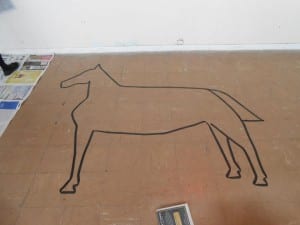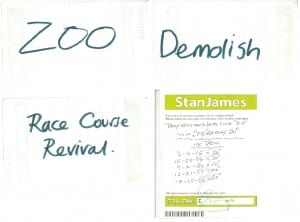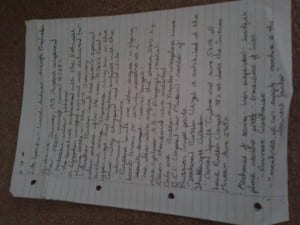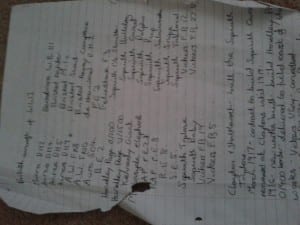The days leading up to the final performance were filled with the final changes to the piece and the last bits of sewing to create the patchwork material stretching from one end of the weighing room to the other.
We added a couple of sections to the beginning of the piece, mainly in the transitions, to fill dead space and hopefully become a familiar face to the audience throughout. A couple of the other groups want to use a rotation system for the audience. However, because their pieces may vary in length the audience may find that they have to wait a little while for the next piece. The audience reconvene in the first half of the weighing room, so our sub-group will set up an area in the corner where we will be applying make-up and brushing each others hair, as if we are getting ready for an evening out. But the most prominent addition will applying tea to our legs and drawing a line, using eyeliner, to create the effect of stockings. Goodman explains:
Women such as Helen Johnson and her friends wanted to look their best when they went out on a Saturday night… “There were no tights, prior to the war everyone wore stockings… we used to enlist the help of our best friend who would apply this [Leg Tan] with a sponge or cotton wool, then there was a delicate operation of putting a pencil mark down the back of the leg for the seam.” ((Goodman, Philomena (2002) Women, Sexuality and War, Hampshire and New York: Palgrave, p. 66.))
By physically helping each other to apply the eyeliner, we wanted to demonstrate togetherness and sisterhood, connoting the women pulling together when they’re husbands were away. In addition, we want to show a contrast between our femininity and the masculine war theme, where two members of the group are acting as Officers. This juxtaposition should not only be aesthetically pleasing but will create the feeling of war from different perspectives. We will also set the scene by playing war-time songs, which will also be a reoccurring addition throughout.
When the rotation finishes our group will join the Officers at the front of the weighing room. We hope that the assembly of the us all together will paint a picture of the past, and shows a united front in the same light as when the first and second World Wars originally started. At this point we will then lead the audience into the next section, becoming the transition.
The ‘factory scene’ is our main piece and we are aiming to emphasise the change in women’s roles when war began. As explained in my previous post, Becoming a Woman of War, we will be contrasting our femininity with the bleak setting in the room, and the sound of machinery. However, where we position our audience in our scene has been an issue. We decided to use a long bench, found in the first section of the weighing room, and place it in the kitchen area of our space. We can only sit 4 or 5 members of audience in there and the rest will be at the entrance to the space. Though this is not ideal if the audience is large, we hope that all the different angles that the audience view our scene will make it a unique experience for each audience member.
The last time the audience see us will be outside, where the ‘Restoration Group’ is showing the audience aspects of the building, one being the service hatch where gingerbread and alcoholic drinks were originally served. From here we will be serving the home-made gingerbread. The juxtaposition of past and present in one space should hopefully highlight the rich history of the site, and the taste of gingerbread will heighten the warmth and community feeling that our whole group is trying to celebrate.
If these changes are achieved and are successful then we hope the performance will provoke the taste of the past still existing within the walls of the Grandstand.



